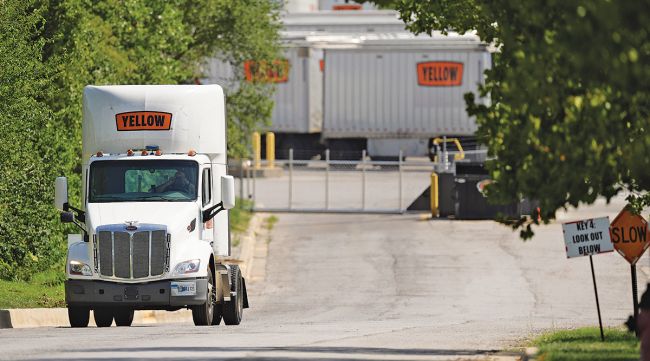A competition for the 169 terminals owned by Yellow Corp. began as the Nashville, Tenn.-based less-than-truckload carrier’s bankruptcy proceedings unfolded, with analysts expecting more players to take part in an upcoming auction beyond those who already have raised their hands.
EFFECT ON LTL SPACE: Competitors absorb Yellow’s business
The nationwide carrier sought bankruptcy court protection on Aug. 6. Seen as a seminal event for the trucking industry by analysts, the filing was swiftly followed by two LTL rivals jumping in with stalking horse bids on consecutive days.
Estes Express Lines announced a $1.3 billion bid for the terminals Aug. 17. Old Dominion Freight Line then offered $1.5 billion to acquire the terminals Aug. 18. A stalking horse bid is an initial offer on the assets of a bankrupt company that sets the low-end bidding bar so others can’t underbid the purchase price.
Old Dominion Freight Line ranks No. 10 on the Transport Topics Top 100 list of the largest for-hire carriers in North America. Yellow is No. 13 and Estes No. 14. Among less-than-truckload carriers, Old Dominion, Yellow and Estes rank 2, 3 and 5, respectively.

Hoexter
Privately held Estes angled for a bargain with the first stalking horse bid, Bank of America Securities Research Analyst Ken Hoexter told Transport Topics.
Estes and Old Dominion’s bids make it much harder for rivals to enter the process, Hoexter said, and the team running the bankruptcy proceedings may see the competing bids as a notice of industry interest and opt to sell the terminals in smaller batches in an attempt to obtain more value than they might with the sale of the whole portfolio to one player.
Estes told TT Aug. 17 that it was “important to try to bring a proposal to the Yellow bankruptcy estate and its creditors that would add some value for the benefit of all case constituents and reduce some of the uncertainty surrounding this bankruptcy process.”
Old Dominion Freight Line declined to comment.
Richmond-Va.-based Estes will not, however, provide a $230 million loan to keep Yellow running while its assets are sold off, as was mooted at an Aug. 11 U.S. Bankruptcy Court-District of Delaware hearing.
Top LTL Carriers
- 1. FedEx Freight
- 2. Old Dominion Freight Line
- 3. Yellow Corp.
- 4. XPO
- 5. Estes Express Lines
- 6. TFI International
- 7. ABF Freight
- 8. R+L Carriers
- 9. Saia Inc.
- 10. Southeastern Freight Lines
Instead, the largest of the company’s shareholders, MFN Partners, will team up with fellow hedge fund Citadel Credit Master Fund to provide a combined $142.5 million. Citadel will provide $100 million while MFN will stump up the rest.
Miami-based Citadel bought out Apollo Global Management’s $485 million loan to Yellow on Aug. 11. Citadel, which became Yellow’s largest debt holder with the purchase, immediately expressed an interest in providing a loan, known as debtor-in-possession (DIP) financing.
The terms of the loans were much more favorable to Yellow than what Apollo was offering, Yellow attorney Allyson Smith told the bankruptcy court Aug. 17, noting that the DIP fee would be 4% rather than 22%-34%, equating to savings of between $27 million and $42 million for Yellow.
The bankruptcy is a consequential event in the LTL sector’s history, said BOA’s Hoexter, and will have positive impacts on margins and price. The sale of the terminals will have an impact similar to that of the bankruptcy of Consolidated Freightways in 2002, he said.
“This is a chance to get a lot of really good terminals,” said Lee Clair, managing partner at management consultancy firm Transportation and Logistics Advisors.
“These are opportunities you just don’t get that often,” said Hoexter.

Adamo
Ken Adamo, chief of analytics at DAT Freight & Analytics , said he would not be surprised to see LTL carrier Saia Inc. or Greenwich, Conn.-based XPO Inc. enter the auction. XPO, which ranks No. 5 on TT’s Top 100 list of for-hire companies in North America as well as No. 4 in the LTL rankings, declined to comment.
Saia is keeping its cards close to its chest, but CEO Fritz Holzgrefe told TT Aug. 24: “As part of our long-term planning, we continue to look for opportunities to expand our service area and enhance the service we offer our customers. To the extent that real estate becomes available across the industry, we will consider potential opportunities to enhance our coverage.”
Yellow’s terminals are some of the oldest in the country, but are large and in the best locations, said TandLA’s Clair.
“There are terminals in the network that are worth a lot of money, some that are worth something and others that will be sold,” Clair said.
“When you have a chance to accelerate your build out and get that many properties at the same time, there’s value to that,” said Hoexter, adding that whichever company purchases the assets can then take its time to decide which ones to keep, and which ones to sell.

Ryan Manthir of Shell Global Solutions and Michael Grahe of Navistar discuss the future of the internal combustion engine. Tune in above or by going to RoadSigns.ttnews.com.
Terminals require a great amount of land and cost a lot of money to build and the land is very hard to come by near major metropolitan areas, Clair said. Companies such as Estes and ODFL want access to the big congested markets, he said.
The terminals do not have to be in the best condition, said Clair. An LTL carrier only “needs the potholes to not be so large that they don’t damage your vehicles and the roofs not so leaky that shipments are affected. The Yellow terminals may need more maintenance, but it is not a big deal.”
Any buyer already knows there’s going to be overlap, the question is what can be monetized to offset the initial outlay, DAT’s Adamo said.
When the initial stalking horse bidders (or whoever outbids them) starts to sell the terminals they find redundant to their ambitions, other players will be interested in what the new owner has to offer, said Clair.
The task a buyer of the whole portfolio will be faced with is very similar to the consolidation that Yellow was hoping to carry out with its One Yellow initiative — the plan the Teamsters union objected to so vigorously, opposition that led to the bankruptcy filing, Adamo said.






